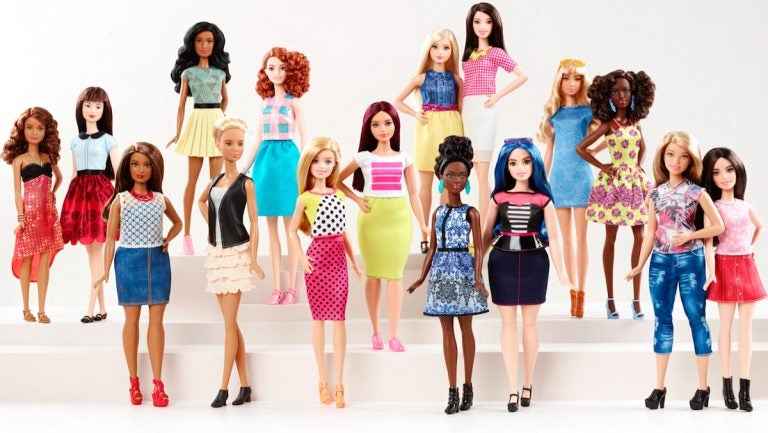3 takes on Barbie’s new look

Barbie announced the expansion of its Fashionistas doll line to include three body types – tall, curvy and petite – and a variety of skin tones, hair styles and outfits. (Image courtesy of Barbie)
Three of our Philly Parenting bloggers weigh in on what the new Barbie means for playtime in their family.
After a major announcement from toymaker Mattel this week, Barbie dolls will now come in three new shapes and sizes — curvy, petite and tall — as well as seven skin tones, 22 eye colors and 24 hairstyles.
It’s a change that comes nearly 60 years after Barbie’s debut amidst concerns that Barbie’s original slim, blonde look is out of touch with the types of dolls kids want to play with.
Three of our Philly Parenting bloggers weigh in on what the changes mean for playtime in their family.
 I’m a Barbie girl, Rachee Fagg
I’m a Barbie girl, Rachee Fagg
Without apology, I love Barbie. I loved playing with Barbie when I was young and when I had my own kid, I was excited to present her with her first Barbie to pass on the play. It always confused me when people would express their extreme dislike, hate even, of Barbie. Sure, with her blonde hair and perfect body, she looked nothing like me, but hat was what I loved about her. As a child growing up in an overweight family, Barbie was everything that I wasn’t, and playing with her was an escape I often needed from myself.
I come from a fat family. We were our weight. There weren’t messages of loving your total self. The extra pounds that my family carried around were everything. My mom loved my sister and me. She tried to shield us from thinking our weight was everything, but there was always an underlying feeling that life would be better if we didn’t weigh so much.
As a mom, I now know there are ways to have a safe discussion about weight, health and nutrition. Thirty-five years ago though, my family struggled. So, I played with Barbies and I loved it.
Barbie had everything that I did not: a wicked wardrobe and fantastic houses. Both scenarios that this fat girl from Philly did not have access to. It was delightful not having the weight (pun intended) of my family’s issues for a few hours.
When I had my daughter and presented her with her own Barbie, I made sure to get a full rainbow of shades for her to play with. Barbie has sparked many creative ideas and conversations for my daughter. Eavesdropping on her play, I’ve never heard her talk about how Barbie looked. To her, Barbie is always the hero.
 Evolving alongside Barbie, Jeff Bogle
Evolving alongside Barbie, Jeff Bogle
My two tween daughters are pencil thin, pasty white and fancy skintight capri pants. So from toes to waist they’re in lockstep with Barbie and her band of merry friends. Neither one of my daughters needs a bra, however, let alone an F-cup sized one. Both have career aspirations outside the world of rock stars and aerobics instructors. (OK, fine, my youngest wants to be a marine biologist which is a profession the blonde doll has on her resume, but still…)
The total package of Barbie has been so off-putting to me as a dad that I’ve been steering my girls away from “that” aisle since day one. Their mom, grandmom, aunts and the other adult women in their lives don’t have that brand of impish demeanor, aren’t buxom and don’t make a habit of rocking 6-inch heels to go to work. And no one at all, outside those on the set of an adult film, wears that much eyeliner.
Barbie simply wasn’t destined to have a role in my daughters’ childhoods. My eight-year-old daughter did get Barbie’s little sister once for her birthday, but she’s been stripped naked and tossed into a box, as per the universal doll policy of young children.
Barbie has just (finally…can we saw finally?) evolved into three new shapes, including “curvy.” The whole thing will make it harder for dads like me to draw such a defined line in the sand.
From birth I’ve been trying to give my kids unique things and genuine experiences whenever possible, instead of stuff that is mass-marketed. The lack of Barbie dolls in our home has been a part of this effort, but I’m heartened to see a Barbie with hips, calves and a waistline closer to reality.
So, should one of my children ask for a Barbie this year, I’m willing to clear a path through that sandy line of demarcation.
Because if Barbie can evolve, so can I.

A less guilty Barbie buyer, Jen Bradley
New Barbies! How exciting! But why do I feel like we’re welcoming Barbie into the 1970s?
As a child who played daily with Barbie dolls during that decade, I had a feminist mom who tried to combat both the body and whiteness messages the doll represented. She made sure to buy me Sunshine Family dolls too, to offer a slightly more human spin.
But at that age, they were all just plastic dolls to me, and I played with them all the same way. There were lots of ambulance scenes that I’m sure a therapist would have a field day with. I spent hours each day playing in my soap-opera doll world.
But then I grew up and went to graduate school and started to have some feelings about those unrealistically imagined dolls. They were too blonde, too white, too skinny, and too concerned with appearance. If I had daughters, they sure as hell wouldn’t be playing with Barbies.
And then I had daughters.
I did fine with my first. It was pretty easy to hold my ground, since she half-heartedly asked, maybe twice, for a Barbie. But my mom ended up getting her some, excited that the dolls mirrored my daughter’s brown skin. She didn’t play with those or any other dolls, so it was a non-issue.
Then her little sister came along, playing with her big sister’s castaways and begging for Barbies before she hit two. I said no. And no again at ages three and four. I tried to explain my reasoning, but at five years old she reported back that “all of her friends” played with Barbie. She was right. I found myself reminiscing about how much I loved playing with mine, and I caved to kindergarten peer pressure.
I made sure our Barbies had different skin tones. I made sure she had astronaut Barbie and veterinarian Barbie and teacher Barbie. But all those Barbies still have identical features, hair and body type. Her “diverse” Barbies look like white Barbies with a different shade of paint, and regardless of color, every single one of them would topple over if they sported those ridiculous proportions in real life.
The new Barbie collection signifies progress. There’s still room for improvement, but this is an enormous and grossly overdue step in the right direction.
While Barbie has been criticized about this stuff for decades, recent social media movements and doll hacks have helped hit Mattel where it hurts — a huge drop in profits over recent years.
Suddenly, Mattel wants to do better. For the girls, of course.
Will we buy the new Barbies? Yes. But we were already invested, so mostly I’ll feel less guilty about it.
WHYY is your source for fact-based, in-depth journalism and information. As a nonprofit organization, we rely on financial support from readers like you. Please give today.

